CDL Practice Tests: Flatbed Cargo Securement
Choose A Section:
Go!What is the minimum WLL of each tiedown used to secure crushed or flattened vehicles?
- 10,000 lbs
- 2,268 lbs
- It depends on the vehicle
- 5,000 lbs
Option 2:
Has containment walls on three sides that:
- Extend to the full height of the load
- Block against cargo movement in the forward, rearward, and one sideways direction.
Secures each stack of vehicles with a minimum of two tiedowns, each having a minimum WLL of 2,268 kg (5,000 lb.).
Option 3:
Has containment walls on two sides that:
- Extend to the full height of the load.
- Block against cargo movement in the forward and rearward.
Secures each stack of vehicles with a minimum of three tiedowns, each having a minimum WLL of 2,268 kg (5,000 lb.).
Option 4:
Has a minimum of four tiedowns per vehicle stack with each tiedown having a minimum WLL of 2,268 kg (5,000 lb.).
When loading paper rolls with eyes horizontal, which of the following is not a requirement for stacking a second layer:
- It must be blocked against an eye-vertical blocking roll resting on the floor of the vehicle that is at least 1.5 times taller than the diameter of the roll being blocked.
- The bottom layer must extend all the way to the front.
- All the wells in the layer beneath must be filled
- Place second layer with eyes vertical.
Requirements for eyes crosswise: secure stacks of paper rolls from front-to-back movement
- Do not load paper rolls on a second layer unless the bottom layer extends to the front of the vehicle.
- Load paper rolls on higher layers only if all wells in the layer beneath are filled.
-
Secure the foremost roll in each upper layer (or any roll with an empty well in front of it) against forward movement:
- Either by placing it in a well formed by two rolls on the lower row whose diameter is equal to or greater than that of the roll on the upper row.
- Or by banding it to other rolls.
- Or by blocking it against an eye-vertical blocking roll resting on the floor of the vehicle that is at least 1.5 times taller than the diameter of the roll being blocked.
Specific securement methods are required for boulders that:
- Weigh more than 5,000 lbs, or have a volume of more than 1.25 cubic meters.
- Weigh more than 11,000 lbs, or have a volume of more than 2 cubic meters.
- Weigh more than 5,000 lbs, or have a volume of more than 4 cubic meters.
- Have more than five distinct sides.
The requirements in this section apply to any piece of natural, irregularly shaped rock that:
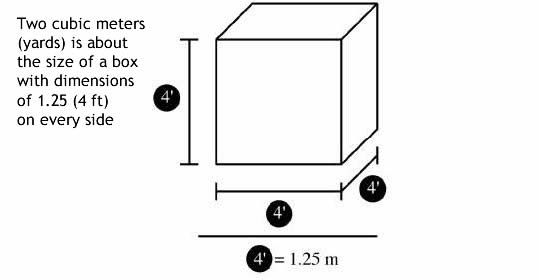
Weighs more than 5,000 kg (11,000 lb.) or has a volume greater than two cubic meters
Is transported on an open vehicle or in a vehicle whose sides are not designed and rated for the transportation of boulders.
Load securement for cargo weighing 29,650 lbs must be able to withstand upward force of how many lbs?
- 14,825 lbs
- 5,930 lbs
- 29,650 lbs
- 30,000 lbs
How strong must the vehicle structure and anchor points be?
All elements of the vehicle structure and anchor points must be strong enough to withstand the forces described on page 7.
- Forward force: 0.8 g (80%)
- Rearward force: 0.5.g (50%)
- Sideways force: 0.5 g (50%)
- Upward force: 0.2 g (20%)
Which of the following can be used as part of the cargo securement system?
- Vehicle structure.
- All of these are valid.
- Blocking and bracing equipment.
- Securing devices.
What is a securement system?
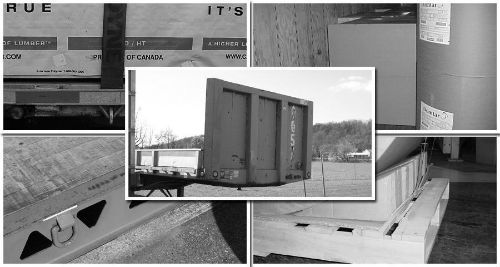
A securement system is a securement method that uses one or a combination of the following elements:
- Vehicle Structure.
- Securing Devices.
- Blocking and Bracing Equipment.
What is the minimum WLL required of tiedowns securing loaded intermodal containers on non-chassis vehicles?
- 50% of the loaded weight of the container.
- It depends on the length of the container.
- 80% of the loaded weight of the container.
- 20% of the loaded weight of the container.
Secure each container to the vehicle by:
- Either chains, wire ropes, or integral devices that are fixed to all lower corners.
- Or crossed chains that are fixed to all upper corners.
- Or both.
Secure the front and rear of the loaded container independently.
Secure the four corners using tiedowns that are attached to the loaded container.
The tiedowns must have an aggregate working load limit of at least 50% of the loaded weight of the loaded container.
Attach each chain, wire rope, or integral locking device to the container in a manner that prevents it from becoming unfastened while in transit.
Which of the following is not a requirement of wood used as blocking or bracing?
- It should be properly seasoned.
- It should be painted.
- It should be free of decay and structural defects.
- Hardwood is recommended.
If wood is used:
- Hardwood is recommended.
- It should be properly seasoned.
- It should be free from rot or decay, knots, knotholes, and splits.
Requirements for securing two stacks of shortwood loaded side-by-side include:
- All of these are required.
- At least one tiedown is used lengthwise across each stack.
- There is no space between the stacks of logs.
- The highest log is no more than 8 ft above the deck.
Additional requirements securement for two stacks side-by-side
In addition to the requirements for shortwood loaded crosswise, load two stacks side-by-side so that:
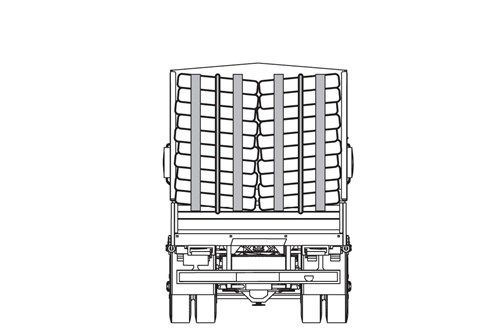
- There is no space between the stacks of logs.
- The outside of each stack is raised at least 2.5 cm (1 in) within 10 cm (4 in) of the end of the logs or from the side of the vehicle.
- The highest log is no more than 2.44 m (8 ft) above the deck.
- At least one tiedown is used lengthwise across each stack.
What is the minimum requirement for securing roll-off and hook containers?
- All of these are acceptable.
- Two hooks, or an equivalent mechanism, securing both sides of the container to the vehicle chassis.
- One tiedown attached to both the vehicle chassis and the container chassis.
- Two tiedowns installed lengthwise, each securing one side of the container to one of the vehicle's side rails.
Secure to the rear of the vehicle with at least one of the following three mechanisms:
-
Rear Mechanism 1:
One tiedown attached to both the vehicle chassis and the container chassis.
-
Rear Mechanism 2:
Two tiedowns installed lengthwise, each securing one side of the container to one of the vehicle's side rails.
-
Rear Mechanism 3:
Two hooks, or an equivalent mechanism, securing both sides of the container to the vehicle chassis at least as effectively as the tiedowns in the two previous items.
Option #3 for securing metal coils transported with eyes lengthwise includes all of the following except:
- Attaching at least two tiedowns through the center of the coil.
- Using blocking or friction mats to prevent forward movement.
- Attaching at least one tiedown over the top of the coil near the front of the coil.
- Attaching at least one tiedown over the top of the coil near the rear of the coil.
Tiedowns, Single Coil Option #3
Option #3 is the same as Options #1 and #2, except that the two tiedowns that attach through the eye of the coil are replaced with two tiedowns that pass over the front and the rear of the coil.
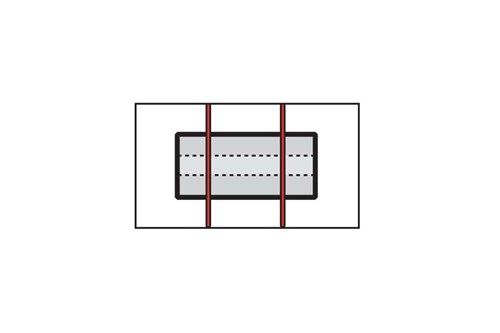
Attach at least one tiedown over the top of the coil near the front of the coil.
Attach at least one tiedown over the top of the coil near the rear of the coil.
Use blocking or friction mats to prevent forward movement.
About The Flatbed Cargo Securement CDL Manual
Studying the flatbed cargo securement CDL manual is not a requirement for getting your CDL permit or license. It is required knowledge for flatbed drivers.
Some questions you should be able to answer for flatbed cargo securement:
- What is the minimum Working Load Limit of a tiedown used to secure logs?
- What is the minimum weight of a shipment of paper rolls that would require specific securement requirements?
- When securing concrete pipe over 45 inches loaded crosswise, which direction must the tiedowns on the front half of the load run?
- What is a cab shield?
- When securing concrete pipe over 45 inches loaded crosswise, which direction must the tiedowns on the rear half of the load run?
- What is a dunnage bag?
- Who is responsible for inspecting securing devices and cargo within the first 50 miles?
- How many tiedowns are required on a stack of shortwood loaded crosswise?
- What is the minimum working load limit of each tiedown used to secure crushed or flattened vehicles?
- Define 'bolster'
- What is a hook-lift container?
- When a tiedown is attached directly to the cargo, what is the ideal angle where it attached to the vehicle?
What is a securing device?
Any device specifically manufactured to attach or secure cargo to a vehicle or trailer:
- Synthetic Webbing
- Chain
- Wire rope
- Manila rope
- Synthetic rope
- Steel strapping
- Clamps and latches
- Blocking
- Front-end structure
- Grab hooks
- Binders
- Shackles
- Winches
- Stake pockets
- D-rings
- Webbing ratchet
- Bracing
- Friction mat
What is a tiedown?
A combination of securing devices that forms an assembly that:
- Attaches cargo to, or restrains cargo on a vehicle.
- Is attached to anchor point(s).
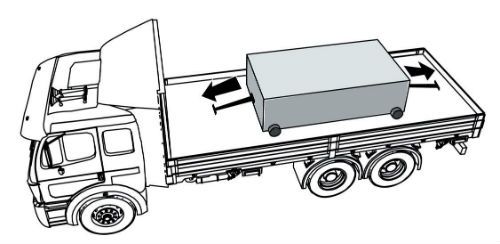
Some tiedowns are attached to the cargo and provide direct resistance to restrain the cargo from movement.
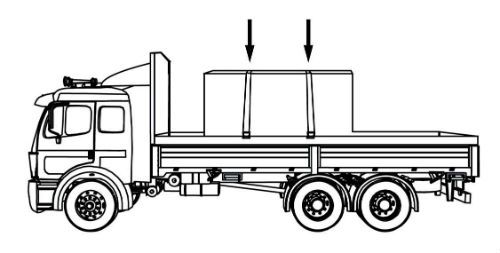
Some tie-downs pass over or through the cargo. They create a downward force that increases the effect of friction between the cargo and the deck. This friction restrains the cargo.
 Related Cargo Securement Terms That Every Driver Should Know:
Related Cargo Securement Terms That Every Driver Should Know:
-
Tiedown:
A combination of securing devices which form an assembly that attaches cargo to, or restrains cargo on, a vehicle or trailer, and is attached to anchor point(s).
-
Contained:
Cargo is contained if it fills a sided vehicle, and every article is in contact with or sufficiently close to a wall or other articles so that it cannot shift or tip if those other articles are also unable to shift or tip.
-
Blocking:
A structure, device, or another substantial article placed against or around an article to prevent horizontal movement of the article.
How should tiedowns be attached?
Tiedowns can be used in two ways:
-
Attached to the cargo:
- Tiedowns attached to the vehicle and attached to the cargo.
- Tiedowns attached to the vehicle, pass through or aroundan article of cargo, and then are attached to the vehicle again.
-
Pass over the cargo:
- Tiedowns attached to the vehicle, passed over the cargo, and then attached to the vehicle again.
Tiedown placement:

Place the tiedown as close as possible to the spacer.
Position the tiedowns as symetrically as possible over the length of the article.

Position the tiedowns to preserve the integrity of the article.







 TT On Facebook
TT On Facebook